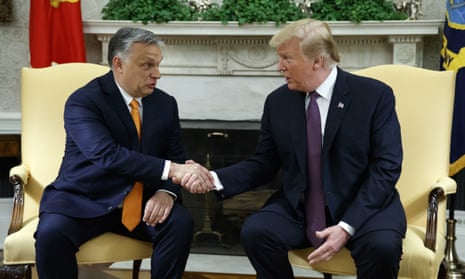How suited President Donald Trump and his Hungarian counterpart, Viktor Orbán, seemed as they sat together in the White House this week, their heavy bodies and craggy faces projecting a brutalist power. Their expensive dark suits and the elegant surroundings did nothing to hide their streetfighter natures and their air of self-satisfaction at their accomplishments.
No wonder Trump told Orbán, in parting, “it’s like we’re twins”, bringing out the emotional politicking that’s served him so well to build a fanatically loyal base of supporters in America.
Although Orbán was the first European leader to back Trump during the 2016 US election, their in-person encounter kicked off what is likely to be the perfect transactional friendship – the only kind of friendship strongman rulers understand. Each has something the other needs and admires.
For Orbán, legitimation by America boosts his quest to be seen as Europe’s leader of “illiberal democracy,” a deceptive term he often uses to describe Hungary under his rule that masks how his strong-arming of the press and the judiciary has all but destroyed many basic democratic liberties there. In the 2019 Freedom House report Hungary now ranks as “partly free.”
More immediately, Orbán and his proxies want American benediction for their master plan: to become leaders in the European parliament, through a new rightwing coalition shaping up with Matteo Salvini of Italy’s League and the Austrian far-right Freedom party. Such as grouping would be the realisation of that “axis of the willing” on immigration policy that Austria’s chancellor, Sebastian Kurz, called for in 2018 – not the most subtle nod to a former rightwing alliance among three Nazi collaborationist powers.
For Trump, whose mission is to bring the US into alignment with the global right, and to bring home authoritarian-style rule, Orbán can be a valuable ally, and his capture of government and the media an inspiration. The president “would love to have the [political] situation Orbán has”, said one long-time Trump crony and current US ambassador to Hungary, David Cornstein. Nothing for Trump can equal the strategic value of Russia’s assistance, electoral and otherwise, but Orbán could be a better partner for him in Europe than Putin, whose state propaganda has for years targeted the US as the enemy, and mocks him as a “clown” on primetime television.
Certainly, the two men are ideologically aligned, and Trump’s comment at the White House meeting that Orbán was doing “a tremendous job in so many different ways” could be referring to his success at capturing the judiciary. Hungary now has a parallel court system that has cemented executive control over judges on matters of electoral law, corruption, and the right to protest, all areas of great personal interest to Trump.
Trump, a man given to obsessing about his perceived enemies, can also probably relate to Orbán’s antisemitic crusade against George Soros, having himself retweeted and repeated rightwing “anti-globalist” propaganda. And, like Orbán, he may have found nothing wrong with the director of Hungary’s Holocaust museum, Mária Schmidt, praising Miklós Horthy, who backed the Nazis from the start and collaborated in the deportation of Hungarian Jews in 1944.
Nor can Orbán’s decimation and domestication of the media have escaped Trump’s attention. Every trick in the new authoritarian playbook has been used in Hungary to engineer a situation where, by the 2018 elections, “opposition views could not even reach significant portions of the electorate,” as Dr Gábor Polyák of Mérték Media Monitor has asserted. Trump can only dream about replicating the truly spectacular 2018 mass genuflection by Hungarian media luminaries who “donated” almost 500 media properties to a government-allied foundation.
Not surprisingly, Trump gave Orbán special praise for his handling of immigration issues, which involves penning up immigrants in camps. Racial politics and the protection of the white Christian heritage of their countries is one of the master narratives fuelling the right on both sides of the Atlantic. Orbán’s minister of human resources from 2012 to 2018, Zoltán Balog, was a fan of “benevolent separatism” for Romani, including separate schools; and Trump advisers such as Kris Kobach have already suggested eventually setting up “processing towns” to hold immigrants for extended periods.
The secret to Orbán’s success, says a Hungarian former senior official, is his ability to “see what the public wants to hear, and to say that, first to get into power, and then to stay there.” A similar pragmatism marks Trump, who has joked about having an extended term as president and has little incentive to leave office. In this, too, he is Orbán’s “twin.”
